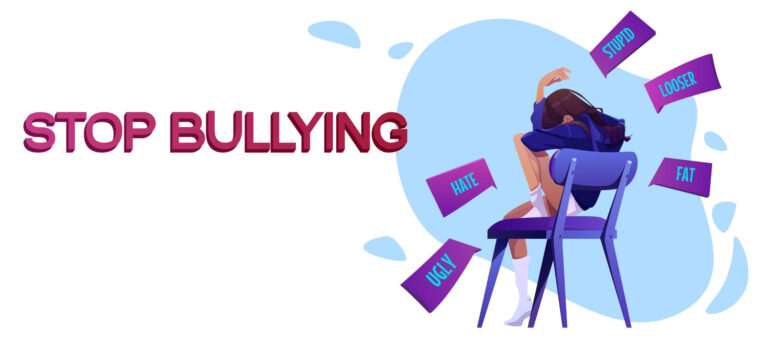Cyberbullying is bullying with the use of digital technologies.
With the increase of children’s innovation of social media, bullying has gotten to be progressively far reaching online.
Our aims through this project are to cooperate and exchange practices and guidelines characteristic of each school in order to attain a common strategy for dealing with cyberbullying.
Teachers learn to distinguish signs that demonstrate that their students may have been victims of bullying and how to address the issue.

With the increase of children’s innovation of social media, bullying has gotten to be progressively far reaching online. New technologies are an integral part of the lives of young people and their functions are closely related to big risks such as cyberbullism. This project is based on the idea that, as it is not possible to make the virtual world completely safe, it is necessary to build children’s resilience to the material and awareness to which they may be exposed and help build their confidence and skills to manage both the tools and the situations of the Information Society. It has taken a modern shape, more complex and more troublesome to distinguish, since it is in some cases concealed by the bullies and false pretenses. One of the major aspect is that the results of bullying are serious. Other than the negative mental impacts which result in self-confidence and self-esteem, casualties of cyber bullying often end up to loose interest in school, which bears negative impacts on their scholarly profit. Moreover, this conduct by the kids causes cases of viciousness and suicide. Other than the reality that children are not legitimately prepared to bargain with such challenges, they are frequently not able to understand that they are casualties of cyberbullism and they suffer in silence. In order to make an initial analysis of the situation we ran discussions and interviews with students and parents in our schools. We ran a survey, this revealed that more than 30% of students were victims of cyber bullying. Approximately 60% of them couldn’t name more than 2 forms of cyberbullism: harassment and denigration, which is the principal cause of early school leaving. Only 10% of the victims reported the incident to their parents or a teacher. 80% of parents didn't know how their children used their time online and they hadn't any idea that their children were victims of cyberbullism. Subsequently, the extend is pointed at both students and parents – we need to create students more responsible users of social media, diminish the frequency of cyberbullism and on the other hand help parents to screen and oversee their children’s online actions, distinguish signs of cyberbulling in the behaviour of their children. Besides the fact that children are not properly equipped to deal with such emotional challenges, they are often not able to understand that they are victims. We think it is important to implement this project, to help both students and parents to be able to distinguish, prevent and fight out against cyberbullism. Moreover, every school ought to upgrade its security methodologies and ensure a safer environment for their students from cyberbullying. This can only take place if the European schools involved will work united sharing materials, information, tools, skills and their appropriate experiences.
We have planned 5 exchanges to the achievement of objectives: C1 Before the first mobility, all groups collect information and do graphs related to cyberbullying in their schools and do inquires about it to discover information in their Countries. They moreover have to find the laws system that directs cyberbullying in their nations and make a report containing all this data. During the C1, they have to program the activities for students: talks about, expressions and crafts workshop in which groups of students will work collaboratively to arrange and understand their thoughts and suppositions about cyberbullying, as well as their creativity in creating workcrafts. Teachers will be involved in work sessions to arrange and show reports they have made and to form a comparative investigation of the circumstances and approaches to cyberbullying in each school and partner Country. At the conclusion of the week, a conference with families, students, school staff and specialists will be held to show the results of the week. C2 Taking after the same method as in C1, the host Institute organizes activities with students approximately on the ways in which they spend their time online and how to utilize the web for instructive purposes. Some time before C2, all partners propose sets of rules that they get to examine during C2 which can be changed. At the conclusion of the week, the results are displayed within the common assembly with all school staff, students and local specialists. C3 The host school organizes activities and lessons with the students involved in the mobility about the different forms of cyberbullying. They discuss cases dealing in cyberbullism that students examine and talk about. At the same time, parents are involved in a conference in arrange to raise their mindfulness of the distinctive forms of bullying. Teachers work on the output – Forms of cyberbullying and how to distinguish them. At the conclusion of the week, results are displayed within a conference. C4 This mobility forecasts the organization of workshops for the students and addresses for teachers on the impacts of cyberbullying, both on the victim and on the bully. Teachers work on the output: Causes and impacts of cyberbullying. The results will be displayed at the conclusion of the week in a conference with the local authorities, the host school staff and the students' parents. Students meet their peers, talk about particular occurrences of cyberbullying and learn how to secure themselves against it. Teachers learn to distinguish signs that demonstrate that their students may have been victims of bullying and how to address the issue. All activities will be connected in each school after the meeting. C5 An online platform will be designed and developed so that all schools will use for the purpose of reporting bullying incidents, thus reducing the incidence in the medium and long term.


Our aims through this project are to cooperate and exchange practices and guidelines characteristic of each school in order to attain a common strategy for dealing with cyberbullying. At all times we will focus on sts and involve them in all activities, which will allow them to express their views and contribute actively. Moreover, we will invite parents to join the activities and, at same time, organize workshops for them. The main point of the project is to form a formal setting of five European schools to work together and create a long-term programme on the issue of cyberbullism, which is necessary for the wellbeing of young people. We need to give a strong impact on students, parents, instructors and improve the mindfulness of all performing people involved in the risk of bullying. Our specific objectives are: - To decrease the incidence of cyberbullying by at least 50% in 2 years - To raise the awareness of at least 80% of the target group related to all forms of bullying at the end of the 2 project years - To improve parents’ capacity to monitor their children’s online activity by producing one guide for them and running 4 workshops (C2-C4) - To create an online platform for the reporting of cyberbullying incidents which will be used by all the schools starting with the academic year 2021-2022 (C5) - To increase students’ intercultural awareness and communication skills - To develop students’ creativity and critical thinking - To develop the European dimension of our schools through international co-operation As a result of our participation, we are going to produce important outputs, which will be shared and implemented in our schools and shared free on online platforms such as eTwinning, Erasmus Platform Results platform: a. Initial and final analysis of cyberbullying in our schools (IT) b. Guide for online safety (addressed to students) (PT) c. Brochure entitled Causes and effects of cyberbullying (TR) d. Guide for parental control of children’s online activity (PL) e. Online platform B.U.O.N.A. for reporting bullying incidents (addressed to students and parents) (ITT) f. Sets of activities on the topic of cyberbullying for use with students (All partners) The outputs are – expanded mindfulness of young students and teachers to recognize different forms of cyberbullying , expand capacity of parents to recognize signs of cyberbullying, expand capacity of schools to oversee the recognizable events and report cyberbullying episodes. The first priority is: Tackling early school leaving and disadvantage, so we will offer an healthy and friendly environment ,an inclusive program,awareness of ICT instruments by which the students can concentrate on their school priorities and curriculum. By creating the outputs documents and sharing them for free, we reach the core of the project we have chosen. We point to form Open Instructive Assets and Free and Open Source Instructive Program for schools and teachers to utilize on cyberbullying.
Fill out the form for advice on cyberbullying!
Input your search keywords and press Enter.